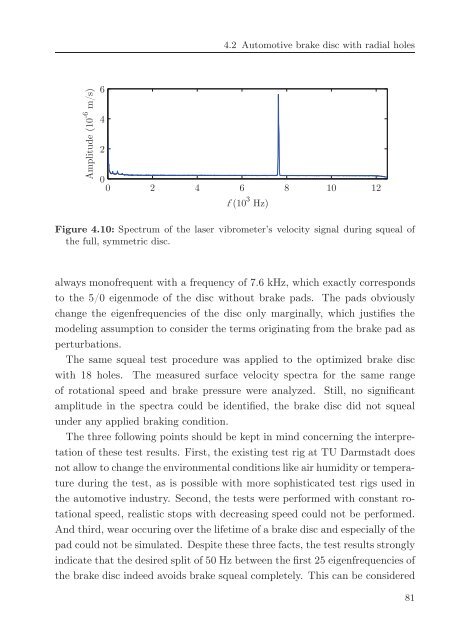Avoidance of brake squeal by a separation of the brake ... - tuprints
Avoidance of brake squeal by a separation of the brake ... - tuprints
Avoidance of brake squeal by a separation of the brake ... - tuprints
Create successful ePaper yourself
Turn your PDF publications into a flip-book with our unique Google optimized e-Paper software.
4.2 Automotive <strong>brake</strong> disc with radial holes<br />
<br />
<br />
<br />
<br />
<br />
<br />
<br />
Figure 4.10: Spectrum <strong>of</strong> <strong>the</strong> laser vibrometer’s velocity signal during <strong>squeal</strong> <strong>of</strong><br />
<strong>the</strong> full, symmetric disc.<br />
always mon<strong>of</strong>requent with a frequency <strong>of</strong> 7.6 kHz, which exactly corresponds<br />
to <strong>the</strong> 5/0 eigenmode <strong>of</strong> <strong>the</strong> disc without <strong>brake</strong> pads. The pads obviously<br />
change <strong>the</strong> eigenfrequencies <strong>of</strong> <strong>the</strong> disc only marginally, which justifies <strong>the</strong><br />
modeling assumption to consider <strong>the</strong> terms originating from <strong>the</strong> <strong>brake</strong> pad as<br />
perturbations.<br />
The same <strong>squeal</strong> test procedure was applied to <strong>the</strong> optimized <strong>brake</strong> disc<br />
with 18 holes. The measured surface velocity spectra for <strong>the</strong> same range<br />
<strong>of</strong> rotational speed and <strong>brake</strong> pressure were analyzed. Still, no significant<br />
amplitude in <strong>the</strong> spectra could be identified, <strong>the</strong> <strong>brake</strong> disc did not <strong>squeal</strong><br />
under any applied braking condition.<br />
The three following points should be kept in mind concerning <strong>the</strong> interpretation<br />
<strong>of</strong> <strong>the</strong>se test results. First, <strong>the</strong> existing test rig at TU Darmstadt does<br />
not allow to change <strong>the</strong> environmental conditions like air humidity or temperature<br />
during <strong>the</strong> test, as is possible with more sophisticated test rigs used in<br />
<strong>the</strong> automotive industry. Second, <strong>the</strong> tests were performed with constant rotational<br />
speed, realistic stops with decreasing speed could not be performed.<br />
And third, wear occuring over <strong>the</strong> lifetime <strong>of</strong> a <strong>brake</strong> disc and especially <strong>of</strong> <strong>the</strong><br />
pad could not be simulated. Despite <strong>the</strong>se three facts, <strong>the</strong> test results strongly<br />
indicate that <strong>the</strong> desired split <strong>of</strong> 50 Hz between <strong>the</strong> first 25 eigenfrequencies <strong>of</strong><br />
<strong>the</strong> <strong>brake</strong> disc indeed avoids <strong>brake</strong> <strong>squeal</strong> completely. This can be considered<br />
81

















